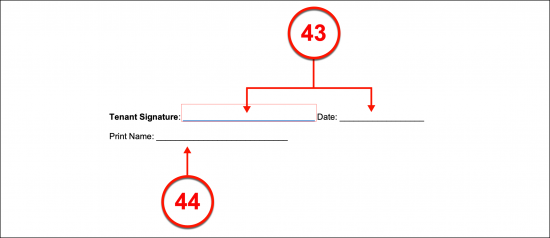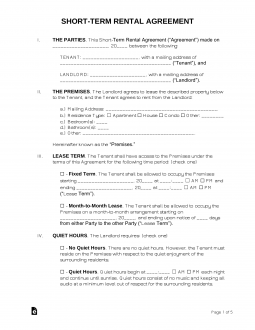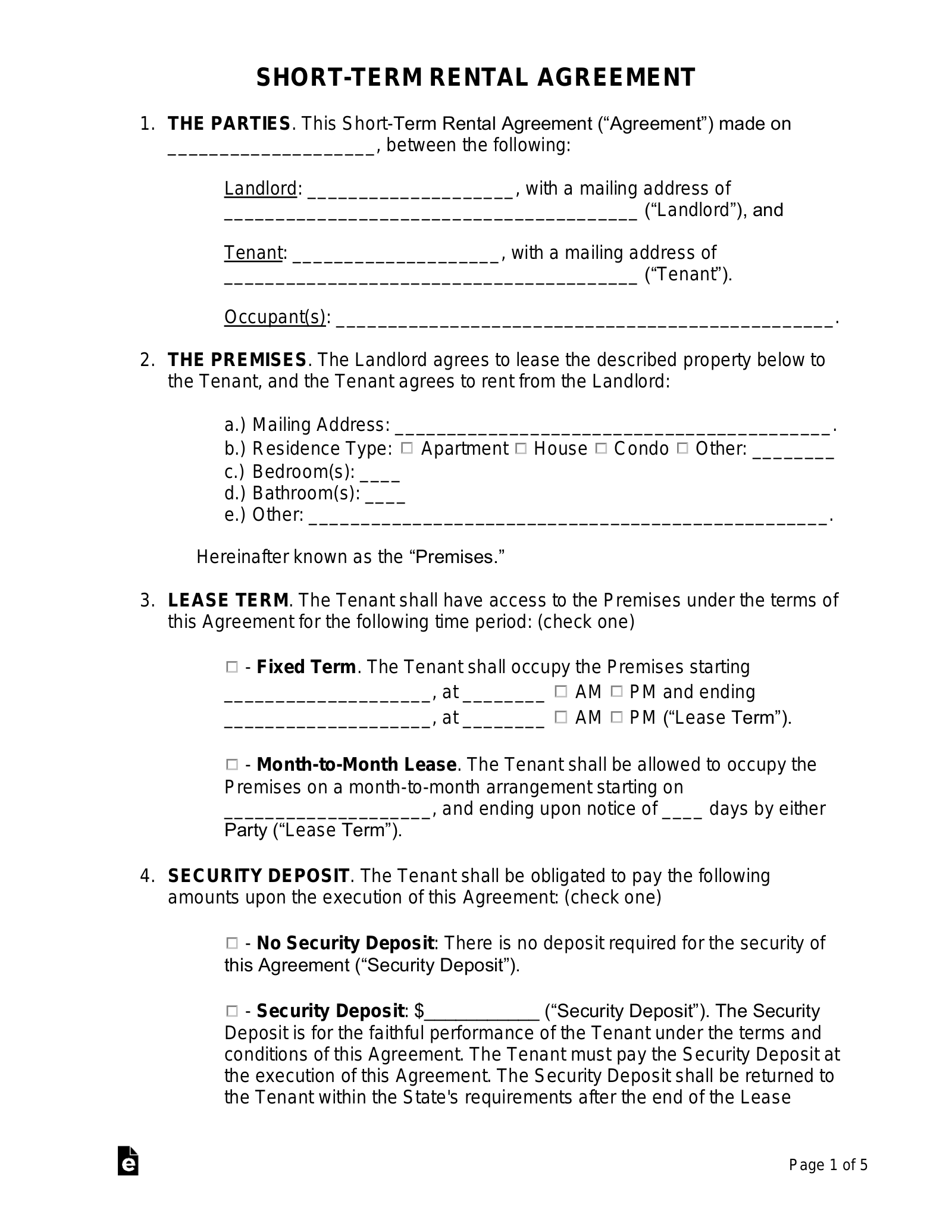Updated April 11, 2024
A short-term or vacation rental agreement is a lease that is made between a landlord and tenant that is generally under 30 days. The agreement is most common for higher-end properties to outline the exact terms and conditions of the rental period.
A short-term lease must follow applicable State laws, and if the housing structure was built before 1978, it must be furnished along with the Lead-Based Paint Disclosure Form.
What Should be Included?
- Start and End Dates;
- Rent ($);
- Property Address (full description)
- Amenities (Wifi, kitchen appliances, Cable TV, etc.);
- Maximum Number (#) of Guests; and
- House Rules
Table of Contents |
What is a Vacation Rental Agreement?
A vacation rental agreement is a lease between a landlord and tenant for under 30 days. Unlike a standard lease, the landlord will be responsible for all utilities, services, and any other expenses attributed to the property.
How to Rent a Vacation Home (8 steps)
- Find out the Local Laws
- Prepare the Property
- Take High-Quality Photographs
- Marketing the Property
- Post Online
- Verify Prospective Tenants
- Finalizing the Transaction
- Checkout (Tenant leaves)
1. Find out the Local Laws

Due to certain communities taking a stand against allowing private residences to be rented, there has been legislation proposed in many areas of the country that prohibit or tax this type of leasing. Be sure to check with a local real estate attorney or real estate agent before listing your property for rent.
2. Prepare the Property

In today’s rental market, tenants want to be provided with the same amenities and services as provided in a boutique hotel or bed and breakfast. This will involve providing:
- Appliances (microwave, coffee maker, etc.);
- Bed linens and pillows;
- Cleaning service;
- Internet (WiFi);
- Cable;
- Shampoo and Soap; and
- Towels
The above-listed items do not have to be expensive, and due to the negligence of most tenants, the base or economy models should be made available.
3. Take High-Quality Photographs

A picture is worth a thousand words and can be the determining factor in a potential tenant selecting your property versus another. It is highly recommended to hire the services of a professional due to the potential amount of money at stake.
Be sure to have the photos focus on the positive aspects of the rental, such as views, landscapes, features, or any detail that could sway a potential renter.
5. Post Online
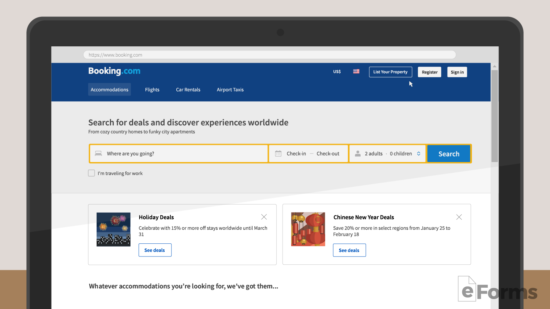
If the landlord decides to market the property themselves, the Internet will be their best tool. It’s recommended to choose the website that best fits your needs.
| Website | Fees | Upfront Costs | Tenant Profiles | Payment | Types | Best for |
| Airbnb | 3% (*6% to 15% charged to the guest) | $0 | Yes | At reservation | shared rooms, rooms, and homes | Seasonal rentals |
| VRBO + Homeaway | 3% | $499 | No | At reservation or check-in | homes | Year-round rentals |
| FlipKey (by TripAdvisor) | 3% (*5% to 20% charged to the guest) | $0 | No | At reservation or check-in | Rooms and Homes | Seasonal rentals |
| Craigslist | 0% | Free to $20 | No | Check-in | shared rooms, rooms, and homes | Long-term rentals |
| Booking.com | 10% to 25% | $0 | No | At reservation or check-in | shared rooms, rooms, and homes | Seasonal rentals |
6. Verify Prospective Tenants

If the landlord uses Airbnb, they can use the tenant profile feature. This will give the landlord access to reviews made by other property owners when they had hosted the guest. Otherwise, it will be up to the landlord to properly screen the tenants.
Unfortunately, most individuals will not consent to a background or credit check through a Rental Application for a vacation. Therefore, checking any available means online may be the only resource for a landlord.
7. Finalizing the Transaction
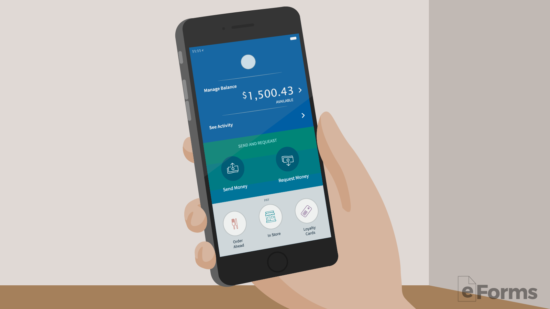
Once the reservation has been finalized, the landlord should try to collect the rent for the selected period. If the landlord used a website that collected the payment on their behalf, they are in good hands as long as the funds were processed accordingly.
However, if the tenant has not made payment to secure their reservation, an online processor such as PayPal, Venmo, or Escrow.com should be used.
If the landlord chooses to accept cash or payment after check-in, they should be wary that due to eviction laws in most States, once the tenant has access to the premises, it can take up to 90 days to remove them.
It’s recommended if the landlord has any valuables in the residence, a security deposit is recommended in addition to the rental payment. This guarantees that if any personal belongings in the home are damaged or missing, the landlord will be at least partially reimbursed.
Sample
Download: PDF, MS Word, OpenDocument
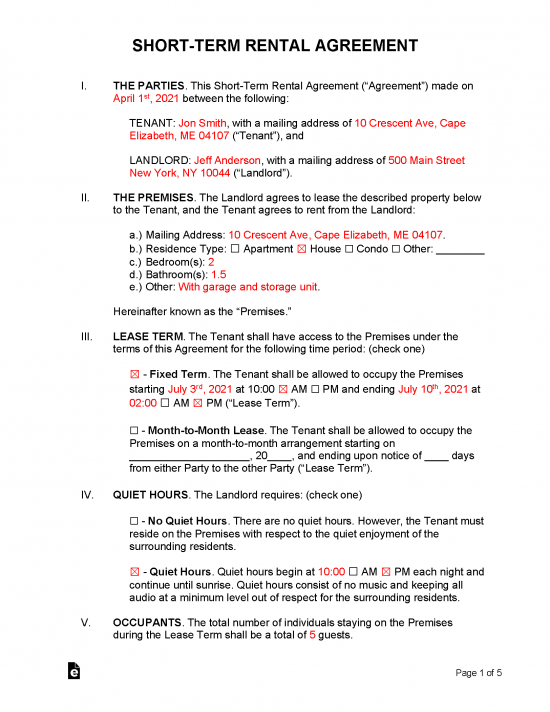
How to Write
Download: PDF, MS Word, OpenDocument
I. The Parties
(1) Date. The calendar date when this agreement is entered should be dispensed to the opening of the first article. Generally, this will be the same as the signature date but may also be after this paperwork’s execution.

(2) Short-Term Tenant. The identity of the Short-Term Tenant must be presented so this document may fulfill its purpose properly.
(3) Tenant Address. The permanent home address of the Tenant is needed to complete the identification process.

(4) Short-Term Landlord. The formal address of the Landlord is required.
(5) Landlord Address. A production of the Landlord’s permanent address should be used to complete the first article.

II. The Premises
(6) Mailing Address. The mailing address for the short-term rental should be furnished to Statement A.

(7) Residence Type. The rental property should be defined as an “Apartment,” “House,” “Condo,” or “Other” dwelling. Select the appropriate checkbox from Statement B to define what kind of property the short-term rental is.
(8) Bedrooms. Enter the number of bedrooms found in the short-term rental.
(9) Bathrooms. The number of bathrooms physically found in the short-term rental property should be dispensed to Statement D.
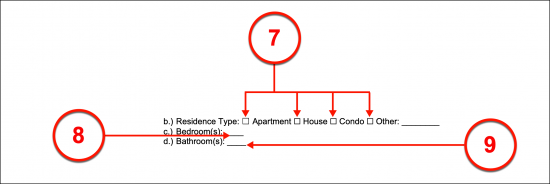
(10) Other. Any relevant description of the property (i.e. a parking spot, a pool, a hot tub, or other amenities) should be included on the line labeled “Other.”

III. Lease Term
Select Item 11 Or Select Item 12
(11) Fixed Term Lease. The lifetime of this agreement should be established. Article III will handle this task by presenting two checkbox statements to choose from. If the property will be rented for a specific number of months with a defined start and termination, select the “Fixed Term” statement. Additionally, supply the first calendar date and time and the final calendar date and time when the Short-Term Tenant and Landlord will participate in this agreement.

(12) Month-To-Month Lease. If the short-term rental property will be leased to the Tenant on a month-to-month basis, then the second checkbox statement in Article III should be chosen. In addition to marking the checkbox, the first date of the rental period must be supplied. Finally, the number of days that the Terminating Party is required to give as notice or a warning that he or she will terminate the agreement must be presented.

IV. Quiet Hours
Select Item 13 Or Select Item 14
(13) No Quiet Hours. Some communities have units that are physically close to one another and may require that their Tenants be mindful of the level of noise they produce. If this is not the case and “No Quiet Hours” will be required of the Short-Term Tenant, then select the first checkbox in Article IV.

(14) Quiet Hours. Select the second checkbox in this area if there will be “Quiet Hours” required of the Short-Term Tenant during his or her occupancy. If so, then document the time of day when the Tenant will be obligated to keep noise to a minimum until sunrise the next day.

V. Occupants
(15) Total Number Of Guests. Document the number of Occupants that will be living in the Short-Term Tenant during the time this lease will be in effect.

VI. Rent
Select Item 16 Or Select Item 17
(16) Fixed Amount. Naturally, the amount of rent the Short-Term Tenant must pay the Landlord to occupy the property must be established. If the Short Term Tenant will be obligated to pay one lump sum by the time this agreement is signed, then select the “Fixed Amount” statement. The dollar amount that must be paid will also need to be supplied to this statement.

(17) Monthly Amount. Choose the second statement, if the Short Term Tenant will be required to pay a set amount once a month while this agreement is effective. This statement requires a report on the rent amount to be paid every month by the Tenant and the two-digit calendar day of the month this rent must be submitted.

VII. Utilities
(18) Landlord Exceptions. Utilities such as electricity, water, and other services that are normally required to maintain a residence will need to be paid for during this agreement. If the Landlord will not be responsible for every utility and service required for the premises, then a record of each utility or service that must be paid for by the Tenant must be supplied to the seventh article.

VIII. Security Deposit
Select Item 19 Or Select Item 20
(19) No Security Deposit. Select the first statement in Article VIII if the Short-Term Landlord will not require a security deposit to be submitted from the Tenant.

(20) Security Deposit. The second statement should be selected if the Short-Term Tenant must give a predetermined dollar amount to hold during the lease’s lifetime. If so, then supply the amount of money required as security to this statement’s language.

IX. Pets
Select Item 21 Or Select Item 22
(21) Does Not Allow Pets. If the Short-Term Tenant will not be allowed to keep or live with pets on the premises, then select the first statement from the ninth article.

(22) Allows Pets. The second checkbox in the ninth article should be selected if the Short-Term Tenant will be allowed to live with pets on the premises being discussed.
(23) Details On Allowed Pets. If the Tenant will be allowed to have pets during this short-term lease, then define the maximum number of pets that he or she may live with. Additionally, the maximum number of pounds of each pet should be furnished where requested.
(24) Pet Security. If pet security or rent will be charged, the dollar amount the Tenant must deliver to the Short-Term Landlord for each pet should be documented. If this amount will not be refundable, then mark the first checkbox in this statement otherwise select the second checkbox if this amount is a refundable deposit.
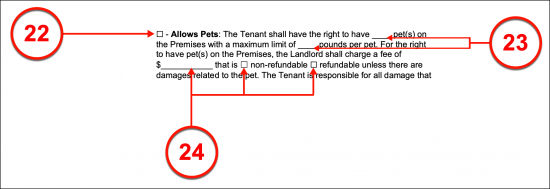
X. Parking
Select Item 25 Or Select Item 28
(25) Landlord Provided Parking. Mark the first checkbox in Article X if the short-term rental is accompanied by one or more parking spaces. If so, the number of parking spaces the Landlord will provide and the dollar amount that must be paid by the Tenant for the use of each parking space should be documented
(26) Payment Term. If the dollar amount the Landlord charges for each parking space will be due only at the signing of this agreement, then the first checkbox in the “Shall Provide” statement should be selected. If the dollar amount will be owed on a monthly basis by the Tenant, then mark the second checkbox in this selection.
(27) Describe Parking Space. If the Landlord will provide a parking space with the short-term rental, then a description of that space (i.e. size, location, parking space number).

(28) Shall Not Provide Parking. If this agreement will not require that the Landlord provide the Tenant with a parking space during this short-term rental then select the “Shall Not” statement.

XI. Fees
(29) Cleaning Fee. Regardless of how short or how long a short-term rental property will be leased for, a certain level of cleanliness will be encouraged (and required) by most states. To this end, if the Landlord will charge the Tenant a “Cleaning Fee” then select the first checkbox (Article XI). A record of the dollar amount making up this cleaning fee will also need to be reported.
(30) Taxes. Select the second checkbox if the Landlord must collect any “Taxes” from the Tenant and produce the dollar amount that will be expected.
(31) Other. If other charges will be placed on the Short-Term Tenant by the Landlord to fulfill this lease, then document each one by identifying it and placing the dollar amount that will need to be paid by the Tenant to the spaces provided in the “Other” option. This checkbox will also need to be selected if it will be applied to this agreement.
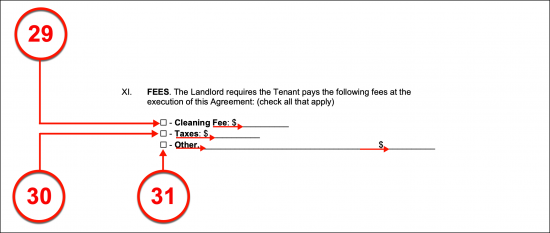
XII. Party Cleanup
(31) Party Cleanup Fee. If the Landlord intends to collect any amount of money to clean up the results of a large gathering (i.e. water damage) then this charge amount must be defined as a dollar amount.

XIII Smoking Policy
Select Item 33 Or Select Item 34
(33) Prohibited. It must be established whether the Landlord will allow smoking or if it is prohibited in the short-term rental. If smoking will not be permitted anywhere on the short-term rental property, then select the checkbox labeled “Prohibited.”
(34) Permitted. If some areas of the property will allow smoking then mark the checkbox “Permitted” and document the areas of the property where smoking will be permitted during the term of the short-term lease.
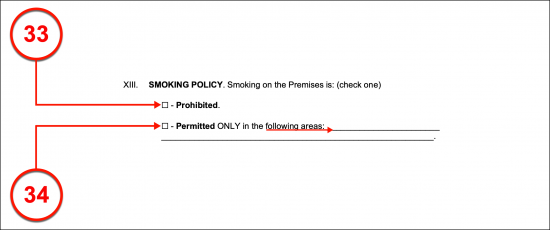
XIV. Person Of Contact
Select Item 35 Or Select Item 36
(35) Premises Manager. If the Property Manager for the short-term rental will be available and on-site during the term of this lease, then the “Does” checkbox in Article XIV. This requires a record of the Property Manager or Agent’s full name, telephone number, and e-mail address to be presented.
(36) No On-Site Manager. If the short-term rental does not have a Property Manager on-site then select the “Does Not” checkbox. It will be important to document the name of the Landlord, his or her telephone number, and e-mail address in this paperwork. This will be the contact information that should be used when the Tenant must request maintenance, repairs, or report an emergency.

XV. Subletting
Select Item 37 Or Select Item 38
(37) Right To Sublet. Some arrangements will enable the Tenant to sublet the short-term rental while this document is active. If so, then the “Has” checkbox must be selected and one of the options this statement contains must be marked since the topic of the Landlord’s approval must be handled by marking one of the checkbox options in this statement. Therefore, if the Landlord will allow the Short-Term Tenant to sublet the premises provided it is approved by him or her beforehand, then the first sublet option should be selected. If the Landlord’s approval will not be required before the Tenant sublets the premises, then select the second sublet option.
(38) No Right To Sublet. If the Landlord will not allow the Tenant to sublet the short-term rental then select the “Does Not” statement’s checkbox.

XVI. Move-In Inspection
Select Item 39 Or Select Item 40
(39) Inspection. If the Landlord and Tenant must perform an inspection then include this requirement in this agreement by marking the checkbox “Inspect.”
(40) Inspection Not Required. If the Landlord and Tenant have agreed that no inspection will be required, then mark the “Shall Not” checkbox statement.

Landlord Signature
(41) Landlord Signature And Signature Date. The Landlord of the short-term rental should perform a review of the conditions above. If the content provided is an accurate representation of the Landlord’s obligations and his or her requirements for the Tenant to rent this property, then he or she must sign this document and distribute the current date beside his or her signature.
(42) Printed Name Of Landlord.
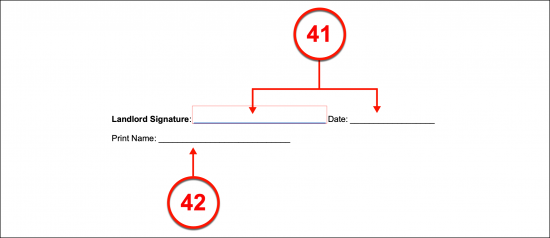
Tenant Signature(s)
(43) Tenant Signature And Date. The Short-Term Tenant will need to enter this agreement by signature. This signature should be provided when the Tenant has determined that he or she can abide by the terms and conditions set to the completed form above. Once this signature is completed, the Tenant must date his or her signature.
(44) Printed Name Of Tenant.
